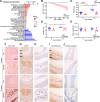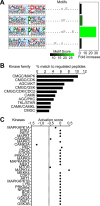A novel phosphoproteomic landscape evoked in response to type I interferon in the brain and in glial cells
- PMID: 34656141
- PMCID: PMC8520650
- DOI: 10.1186/s12974-021-02277-x
A novel phosphoproteomic landscape evoked in response to type I interferon in the brain and in glial cells
Abstract
Background: Type I interferons (IFN-I) are key responders to central nervous system infection and injury and are also increased in common neurodegenerative diseases. Their effects are primarily mediated via transcriptional regulation of several hundred interferon-regulated genes. In addition, IFN-I activate several kinases including members of the MAPK and PI3K families. Yet, how changes to the global protein phosphoproteome contribute to the cellular response to IFN-I is unknown.
Methods: The cerebral phosphoproteome of mice with brain-targeted chronic production of the IFN-I, IFN-α, was obtained. Changes in phosphorylation were analyzed by ontology and pathway analysis and kinase enrichment predictions. These were verified by phenotypic analysis, immunohistochemistry and immunoblots. In addition, primary murine microglia and astrocytes, the brain's primary IFN-I-responding cells, were acutely treated with IFN-α and the global phosphoproteome was similarly analyzed.
Results: We identified widespread protein phosphorylation as a novel mechanism by which IFN-I mediate their effects. In our mouse model for IFN-I-induced neurodegeneration, protein phosphorylation, rather than the proteome, aligned with the clinical hallmarks and pathological outcome, including impaired development, motor dysfunction and seizures. In vitro experiments revealed extensive and rapid IFN-I-induced protein phosphorylation in microglia and astrocytes. Response to acute IFN-I stimulation was independent of gene expression and mediated by a small number of kinase families. The changes in the phosphoproteome affected a diverse range of cellular processes and functional analysis suggested that this response induced an immediate reactive state and prepared cells for subsequent transcriptional responses.
Conclusions: Our studies reveal a hitherto unappreciated role for changes in the protein phosphorylation landscape in cellular responses to IFN-I and thus provide insights for novel diagnostic and therapeutic strategies for neurological diseases caused by IFN-I.
Keywords: Astrocyte; Cerebral type I interferonopathy; Interferon; Microglia; Neurodegenerative disease; Phosphoproteomics.
© 2021. The Author(s).
Conflict of interest statement
The authors declare that they have no competing interests.
Figures








Similar articles
-
Microglia have a more extensive and divergent response to interferon-α compared with astrocytes.Glia. 2018 Oct;66(10):2058-2078. doi: 10.1002/glia.23460. Epub 2018 Jul 27. Glia. 2018. PMID: 30051922
-
Ischemia/Reperfusion Induces Interferon-Stimulated Gene Expression in Microglia.J Neurosci. 2017 Aug 23;37(34):8292-8308. doi: 10.1523/JNEUROSCI.0725-17.2017. Epub 2017 Jul 26. J Neurosci. 2017. PMID: 28747383 Free PMC article.
-
Chronic neurodegeneration induces type I interferon synthesis via STING, shaping microglial phenotype and accelerating disease progression.Glia. 2019 Jul;67(7):1254-1276. doi: 10.1002/glia.23592. Epub 2019 Jan 25. Glia. 2019. PMID: 30680794 Free PMC article.
-
Microglia responses to interleukin-6 and type I interferons in neuroinflammatory disease.Glia. 2019 Oct;67(10):1821-1841. doi: 10.1002/glia.23634. Epub 2019 Apr 29. Glia. 2019. PMID: 31033014 Review.
-
Microglial Interferon Signaling and White Matter.Neurochem Res. 2017 Sep;42(9):2625-2638. doi: 10.1007/s11064-017-2307-8. Epub 2017 May 25. Neurochem Res. 2017. PMID: 28540600 Free PMC article. Review.
Cited by
-
Interferon-α receptor antisense oligonucleotides reduce neuroinflammation and neuropathology in a mouse model of cerebral interferonopathy.J Clin Invest. 2024 Jan 9;134(4):e169562. doi: 10.1172/JCI169562. J Clin Invest. 2024. PMID: 38357922 Free PMC article.
-
Single-cell ultra-high-throughput multiplexed chromatin and RNA profiling reveals gene regulatory dynamics.Nat Methods. 2025 Jun;22(6):1213-1225. doi: 10.1038/s41592-025-02700-8. Epub 2025 May 26. Nat Methods. 2025. PMID: 40419657 Free PMC article.
-
Breaking down the cellular responses to type I interferon neurotoxicity in the brain.Front Immunol. 2023 Feb 3;14:1110593. doi: 10.3389/fimmu.2023.1110593. eCollection 2023. Front Immunol. 2023. PMID: 36817430 Free PMC article. Review.
-
The brain microvasculature is a primary mediator of interferon-α neurotoxicity in human cerebral interferonopathies.Immunity. 2024 Jul 9;57(7):1696-1709.e10. doi: 10.1016/j.immuni.2024.05.017. Epub 2024 Jun 14. Immunity. 2024. PMID: 38878770 Free PMC article.
-
Post-translational modification prediction via prompt-based fine-tuning of a GPT-2 model.Nat Commun. 2024 Aug 7;15(1):6699. doi: 10.1038/s41467-024-51071-9. Nat Commun. 2024. PMID: 39107330 Free PMC article.
References
MeSH terms
Substances
LinkOut - more resources
Full Text Sources

